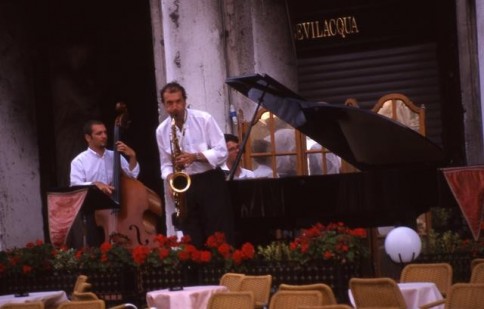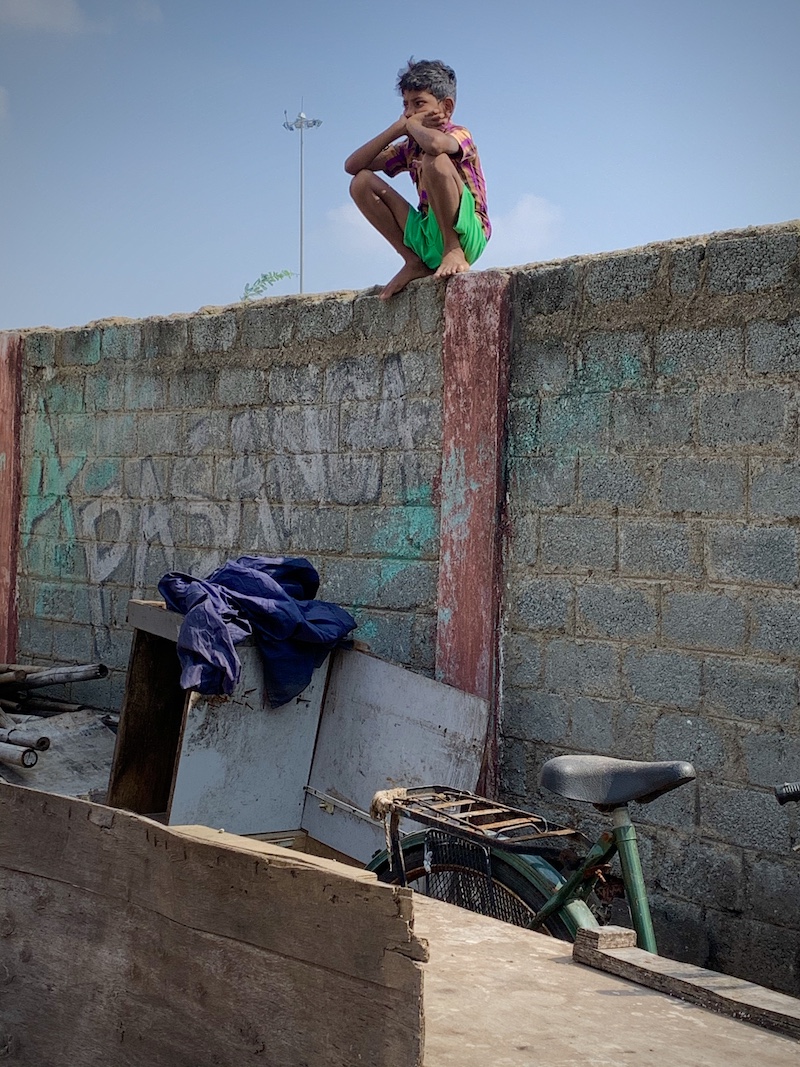On the weekends, Poonga often accompanies musicians and dancers in his neighborhood as they film music videos. He is twelve and sings Gaana, a north Chennai style that emerged as funeral music. Gaana has now evolved as a wildly popular form of self-expression for young Dalit men who continue to face discrimination owing to their caste, class, and address; Gaana music videos can get up to 70 million views. Poonga is here today to watch his mentors and friends in their twenties shoot a music video on an arterial road in their slum neighborhood.
Along the street is a wall that reads “pasanga” or “the guys” in faded yellow lettering. Poonga scales a precarious arrangement of discarded items – a rusty bicycle and a broken shelf. His aunt, a curious onlooker at this spectacle, cautions, “Don’t sit on that wall! It’s so old, it might collapse any moment.” Poonga is a picture of concentration and squats on the wall with his head in hands, barely registering his aunt’s warning as he watches the breakdancers in front of him practice their cartwheels.
Gaana singers challenge their characterization as “dangerous” and “messy” by south Chennai’s more privileged residents. One singer fuses Gaana with Tamil rap to protest this image. He sings that it is the rest of the city dumps its trash in his neighborhood. During the music video shoot, the odor of burning plastic and rubber emerges from the dumpyard just behind the wall. Poonga calls out to me, “It’s just them burning trash – it happens a few times a day.”
In sociological literature on cities of the Global South, the slum overrides the variegated aspects of city life to emerge as the key idiom of urbanism. Voyeuristic images of slum residents portray them as bearers of an “authentic” urbanism of the South (Dovey and King 2012), while the aesthetics of informal settlements are wielded against these residents by state authorities on the quest to rid cities of visual markers of poverty (Ghertner 2015). Both discourses deny slum residents agency to present images that would contradict these singular narratives of their experiences. Gaana musicians present an autobiographical version of urban experience, and challenge the image of their passivity in marginalization by actively registering their dissent. They reject the stigma usually implied in the term “pasanga”, used by privileged Chennaiites to slur young, Dalit men, and instead declare themselves proudly as “pasanga”. In a context where these young men feel that the government and the privileged have both failed them, they assert through their music that male friendships are the scaffolding to endure past broken homes and broken hearts.
After the shoot is over, his mentor walks up to us and says proudly, “He’s the next generation of Gaana.” In my ethnographic fieldwork, I explore how Gaana’s practitioners negotiate caste, class, and address in place-making and cultural practices in the city. Poonga’s picture captures a moment in the process of Dalit self-assertion and their reclamation of stigmatized identities through style, music, and art.
Commentary on Rachel Tanur's Works: Italian Band
 Rachel Tanur’s tableau of street music conjures up an urbanism that is worlds apart from my photograph of the young Gaana singer on a Chennai street. Here, one is left to extrapolate from the opulence of the orange pennant in satin; the perfectly groomed and verdant flower boxes by the street side café; the clean, white tablecloths; the orb of a lamp held up by wrought iron talons at the height of the potential customer – perhaps a tourist – who will most certainly be enticed to take a seat here by the composition of the space and the music wafting across the street. This image is imbued with the suggestion of sound in the forcefulness of the saxophonist’s expression as he blows into his instrument, accompanied by the contrabass and a grand piano. The composition of the picture also hints that this street is for those who are sanctioned to linger rather than loiter. The photographer’s distance from the musicians suggests that she was standing in the middle of the street while taking this picture, ostensibly unfettered by oncoming traffic.
Rachel Tanur’s tableau of street music conjures up an urbanism that is worlds apart from my photograph of the young Gaana singer on a Chennai street. Here, one is left to extrapolate from the opulence of the orange pennant in satin; the perfectly groomed and verdant flower boxes by the street side café; the clean, white tablecloths; the orb of a lamp held up by wrought iron talons at the height of the potential customer – perhaps a tourist – who will most certainly be enticed to take a seat here by the composition of the space and the music wafting across the street. This image is imbued with the suggestion of sound in the forcefulness of the saxophonist’s expression as he blows into his instrument, accompanied by the contrabass and a grand piano. The composition of the picture also hints that this street is for those who are sanctioned to linger rather than loiter. The photographer’s distance from the musicians suggests that she was standing in the middle of the street while taking this picture, ostensibly unfettered by oncoming traffic.
The composition of this picture sees an assemblage of cues that connotes a deliberately produced aesthetic of “quaintness”. We see the tail end of the establishment’s name, “-evilacqua” and even the golden lettering beckons a clientele with expensive tastes. “Bevilacqua” is a Venetian textile “tradition”, as their website describes, that combines historical designs with a “whiff of modernity”. Again, the photographer gives us clues to guess not just from the musicians themselves but from the space that the clientele is expected to have a certain kind of predilection for the ability to afford luxury goods and discern their worth. At the same time, the taste predicted by the curated space is not merely for expensive goods, but requires a certain cultural capital to appreciate a constructed “authenticity” and harkening back to a glorious Italian past that is rejects “rustic or dilapidated” for “quaint and nostalgic”.
There is no greater proof of this than the image of the jazz trio. As jazz has ascended to the status of a “classical” music, it has become estranged from its roots in the African American experience of discrimination in the streets of New Orleans. Now it has become a “serious” music that conveys good taste, exposure to the arts, and cultural capital (Taylor 1985). That it should be played on this luxury street, unlike say, a busker who might have to worry about policing sheds light on the sanctions for some music(s) and their practitioners, patrons, and connoisseurs over others. The street here is envisioned entirely differently from the imagination of the street for rappers on a Harlem street, whose “urbanness” – often code for racial stereotypes – is the very characteristic that might lead to their surveillance on the street (Oliver 2006). The potency of this image is in enabling a viewer to imagine how art is variously emplaced in urban spaces, and which constituencies are deemed to be (il)legitimate occupants of the streets.
